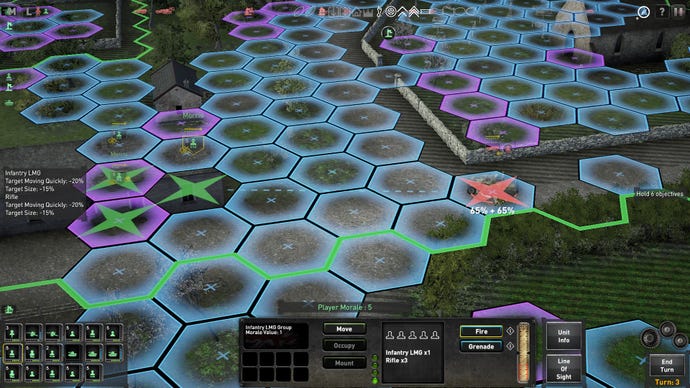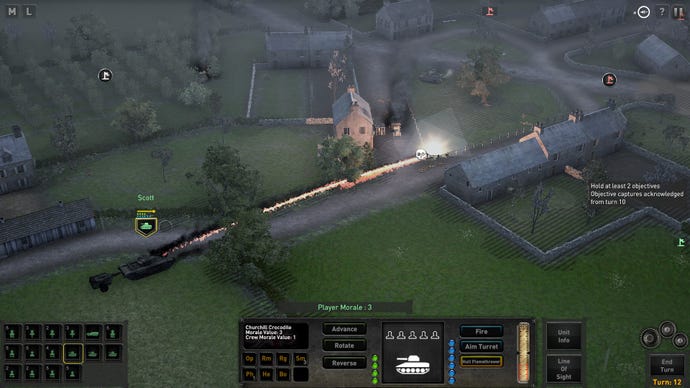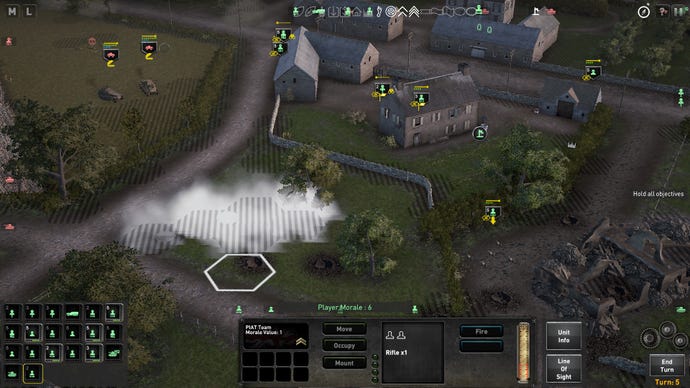Products You May Like
For someone so skeptical of taxonomy, I sure love a good subgenre dive. That’s partly because it’s so easy to find a healthy one now, and there’s a joy in shearing down multiple times and still finding material. You can start from “strategy games are in a good state” and go all the way down to “Turn-based strategy wargames that balance detailed simulation with accessibility and are set in World War 2” and still find several strong entries from the last few years.
But it’s The Troop that grabbed me most. It’s a little surprising, given its modest look, and the stiff competition. I think what clinched it is that The Troop has revealed to me something that I already sort of knew, but hadn’t quite caught hold of: that a tank warfare game is all about the pause.
Of course there’s more to it than that, but fundamentally, you need that little moment of tension and drama as the turret slowly turns, an unseen gunner confirms their setup, and only then does the thing happen. It could be a good thing, or a terrible thing, or an inconclusive one that draws the tension out longer still. The pause makes it dramatic either way.
The Troop isn’t an exclusively tanky game either, and in fact you typically have control of very few at once. Infantry spot and flank and generally both precede and support the charge, or even form the core of it while your metalmen harass and snipe. But they too use the pause. Every effect an attack has is indicated by little floating text, listing them all in turn. Once you’re familiar with the animations you already know, of course, that that last volley took out the whole section. But because there’s that little delay as each death is listed followed by the confirmation that the unit’s out, you wait for it anyway. You get a tiny little thrill out of it anyway, a fullstop to that decision you made.


It often does the little dramatic camera thing a lá XCOM (and a hundred others, yes, but everyone knows XCOM), which highlights that the graphics are part of the charm, too. While Total Tank Generals or Panzer Corps 2 focused on the big picture, The Troop’s skirmish-level fights allow it a detailed 3D engine. It’s not the fanciest; its colour scheme recalls those slightly desaturated rainy days when everything is green, but in a faintly resigned way. But it uses it to its full dramatic effect, without ever overreaching into bombast. Where Second Front has a slightly cartoony look and, say, Valor and Victory was too abstract for me, all this adds up to a game that feels perfectly pitched to carry off a detailed wargame simulation without feeling overly dry or detached, and feeling like a drama about decisions and consequences rather than a game of numbers. At its heart, The Troop feels like a shootout, something even a lot of ostensibly shooty games fail to convey.
It doesn’t hurt that its tutorial is clever, practical, and succinct, and its core campaign scales up comfortably from a tiny scouting confrontation to the tail end of Normandy, with lots of stops along that way that are usually skipped over. Even its beach landing mission gives you the tiniest responsibility instead of overwhelming you with the big one. Dozens of one-off missions are available, plus the traditional Panzer Generals style persistent (and optionally dynamic) campaign where you shepherd a limited set of irreplaceable units who improve with experience.
You don’t really connect with them individually, though, despite their very limited number. Each mission has limited capacity for units, which you kind of rent with a point system, but the selection screen doesn’t tell you what trucks are carrying, so I had no idea I was bringing a second mortar team and not the infantry I needed. On the flip side, it also meant I once took a flamethrower tank by accident (not knowing the brand names, I assumed it was merely a heavy) that I’d have otherwise assumed was too niche. Well it turned out this thing eats nazis and shits ghosts and when I rolled it into a town square it was game over for everyone not made of asbestos.

Drama, see? It’s understated, but damn it works. You also get the option of renting the unit as reinforcements, making it cheaper but arriving late (same) for a potential dramatic turnaround, if they can actually get to a useful position in time. You can continue the campaign even if you lost a mission too, which you probably will if you bring the rookie replacement units, which reduce your starting morale. It’s not worth it, because morale is army-wide, so starting low can mean your entire team will quit an obviously winning battle because you lost two out of twenty units early. Most battles will end in retreat rather than annihilation, preventing a dreary cleanup slog, but I’d love an option to keep fighting even if it didn’t count towards the score or official outcome.
You can sort of do this, in fact, by disabling morale entirely. The Troop describes itself as “a game, not a simulation”, but is nonetheless a pretty good simulation, down to armour penetration, angles, turret rotation, very long ranges, dud shells, and even using destroyed tanks as concealment. That ethos is reflected more in its attitude to the player, as there are many options to tweak things to your liking, like making infantry slinkier, or switching off the icon that tells you when a unit has been spotted. The latter’s a system I have mixed feelings about. It sounds a bit cheaty, but given the long run up times and lack of recon options it kind of works, and I imagine it being not so much magical psychic game powers as someone plain intuiting that the enemy are watching. The limited ability to move in discrete motions makes this, if not a necessity, a justifiable compromise at any rate. It also adds rather than removes drama at times – tank blind spots are terrifying in smoke and fog, and knowing they’ve seen you can cause as much trouble and doubt as never being sure.
Most interestingly, there’s no overwatch/interrupt system by default, which makes recon very dangerous. Traversing bocage or rounding a corner is particularly deadly (there’s unfortunately no terrain destruction, but then bocage should be a major problem in Normandy, right?), and the movement system offers a gradated tradeoff between speed and safety that often feels like you can either sit there and be useless or move forward and lose someone.

Overwatch is transformative enough that I’m impressed both that the game works without it, and that it’s an option. It’s a very player-first kind of game. But going without is the default, I think, because it emphasises the need for a combined arms approach. I hate taking casualties in any game, and I love my perfect ambushes, but realistically in the 40s, someone had to step out into the line of fire. Instead of setting up a magic forcefield of free shots, sometimes you really have to halt everyone and bring the infantry up to take out that rocket launcher. You have to know when to pull a tank out and take a few turns to approach from a different angle rather than get into a dangerous slugging match. And sometimes, when letting your tank spend another turn perfecting its shot (gunners have their own separate action points to do this over multiple turns, unless you’ve committed fully to maximum movement) is right, vs firing now and risking a miss in order to cover that scout’s blunder.
I have few complaints. The enemy always goes first, which feels a bit cheap when you’re on defence, and there are occasional discrepancies – I’ve lost AT units even though the machine was intact and another one wasn’t even fired on, and it’s frustrating not being able to restaff decrewed vehicles in campaign. The line of sight and range displays are less convenient than I’d like, and enemy mortars seem to be insanely deadly, one-shotting entire squads inside buildings while my three mortar teams with multiple spotters were lucky to kill one guy every other turn. It could also really use a save system. I appreciate the commitment to living with your mistakes and losses (the game does autosave every turn, mind), but so many missions start with a tedious five minutes of walking your army into position that I’d rate it significantly higher if there was an option to replay from first contact instead. Especially with infantry, who take an entire turn to get over a hedge, which often means three turns of getting to the hedge, climbing over it, then moving away from it. A “start of mission” save to revert to after setting up would be especially useful on missions where you’re setting up a complex defence.
But I list these grumbles out of professional obligation, not because they give me pause. It’s clear The Troop is an ongoing project for Giant Flame, but even if they don’t go on to tweak and expand it they way I’d like, I’ll have no hesitation in naming it not just my favourite turn based World War 2 game, but a standout strategy game to anyone who’s always looking for that perfect level of detailed-but-friendly simulation.
